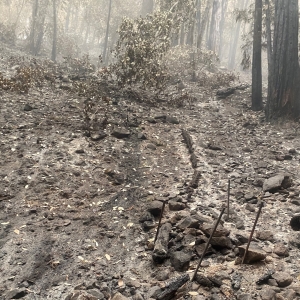The Stream, September 11, 2020: UK Officials Set Up Taskforce to Reduce Sewage Spills
The Global Rundown
The UK’s Department for Environment, Food and Rural Affairs sets up a taskforce to reduce sewage spills in rivers and seas. The US Gulf Coast tries to recover from Hurricane Laura during extreme heat and the pandemic. Cavities found in the Thwaites glacier are contributing to rising sea levels in the Antarctic. The Ohio Environmental Protection Agency commits to stricter limits on nutrient pollution in parts of Lake Erie. An ancient archaeological site in Sudan is being threatened by severe flooding.
“The situation is under control, but if the level of the Nile continues to rise, the measures taken may not be sufficient.” – Marc Maillot, head of the French Archaeological Unit in the Sudan Antiquities Service. Rising Nile floodwaters are threatening to swamp an ancient archaeological site in Sudan that includes the famous Meroe pyramids, a UNESCO World Heritage site. Rivers in Sudan have reached some of the highest ever recorded levels, forcing teams to set up sandbag walls and pump out water to prevent damage at the ruins of Al-Bajrawiya, once a royal city of the two-millennia-old Meroitic empire. Sudan’s ancient civilizations built more pyramids than the Egyptians, but many are still unexplored. Al Jazeera
Latest WaterNews from Circle of Blue
Removing Carbon from Air, Which Increases Water Use, Is No Simple Climate Fix – Certain ways of drawing carbon out of the atmosphere to keep global temperatures in check come with substantial tradeoffs for water use, water quality, and food production, study finds.
HotSpots H2O: In Kenya, Lake Water Rise Endangers Livelihoods and Wildlife – Rising water levels in the lakes along with the Great Rift Valley have pushed thousands in Kenya from their homes, endangering people’s livelihoods and wildlife in the region.
By The Numbers
177,000 The estimated number of people in Southwest Louisiana who lack running water after Hurricane Laura wreaked havoc on the U.S. Gulf Coast last month. Residents in the region are working to recover from the disaster, even as they face extreme heat and the threat of contracting Covid-19. Hurricane Laura was one of the strongest storms to strike this portion of the Gulf, where Louisiana and Texas begin to blend together. One of the major concerns leading up to Laura’s landfall was that evacuations would lead to thousands of new Covid-19 cases. Now that the storm has passed, some local residents fear the hurricane will distract people from taking precautions like wearing masks and standing six feet apart. National Geographic
In context:
- In Pandemic, New Thinking on Responding to Weather Disasters
- Hurricane Laura Critically Damages Louisiana Drinking Water Facilities
15 The number of chief executives of water companies that met with the UK’s environment minister, Rebecca Pow, on Wednesday, where she called on them to take further action to protect the environment, improve leakage levels and safeguard water supplies. The UK Department for Environment, Food and Rural Affairs set up a taskforce to cut the frequency of sewage discharges into rivers and seas from storm overflows, following revelations in the Guardian that water companies released raw sewage into rivers more than 200,000 times last year. The Conservative chair of the environmental audit committee, Philip Dunne, is also pursuing a campaign to change the law to forbid water companies from discharging raw sewage into waterways. The Guardian
Science, Studies, and Reports
British scientists have mapped cavities half the size of the Grand Canyon that are allowing warm ocean water to erode the vast Thwaites glacier in the Antarctic, accelerating the rise of sea levels across the world. Using an aircraft, ship and robot submarine, the British Antarctic Survey and a US team traced the seabed terrain and the bottom of the ice shelf to measure the gaps that have opened between previously grounded sections of the glacier. The study comes at a time when ice loss from glaciers has increased more than fivefold over the last 30 years. If the Thwaites glacier collapses completely, it could raise sea levels by another 25 inches (63.5 centimeters). Many scientists believe that process is already underway, and the author of the study said the most cost-effective way to ease climate impacts such as this is cutting carbon emissions. The Cryosphere
On the Radar
The Environmental Law & Policy Center in Chicago has appeared to force the hand of the Ohio Environmental Protection Agency (OEPA) in seeking solutions to Lake Erie’s ongoing nutrient pollution problem. Days after filing a lawsuit to force the OEPA to create a total maximum daily load (TMDL) for western Lake Erie, Ohio Gov. Mike DeWine announced the OEPA intended to do just that. The lawsuit claims the U.S. EPA failed to create a TMDL previously, which sets a specific limit of nutrient pollution, and violated the Clean Water Act. A spokesman from the OEPA declined to comment on the pending litigation but said the TMDL will be a valuable component of a mitigation strategy for Lake Erie. Great Lakes Now
Jane is a Communications Associate for Circle of Blue. She writes The Stream and has covered domestic and international water issues for Circle of Blue. She is a recent graduate of Grand Valley State University, where she studied Multimedia Journalism and Women, Gender and Sexuality Studies. During her time at Grand Valley, she was the host of the Community Service Learning Center podcast Be the Change. Currently based in Grand Rapids, Michigan, Jane enjoys listening to music, reading and spending time outdoors.






Leave a Reply
Want to join the discussion?Feel free to contribute!